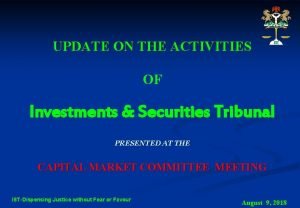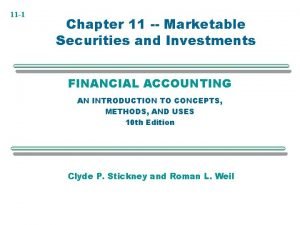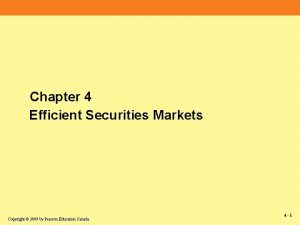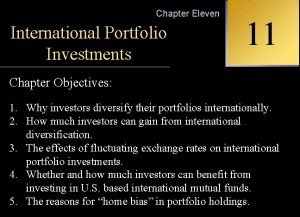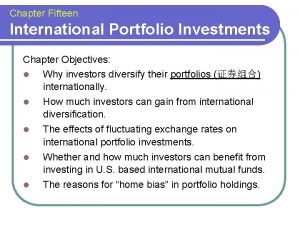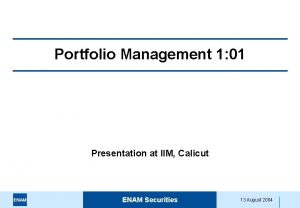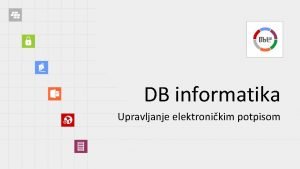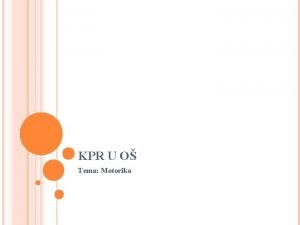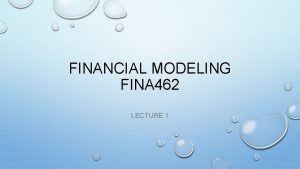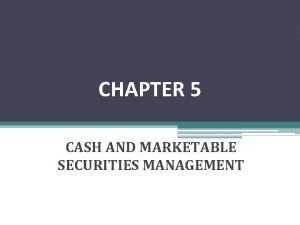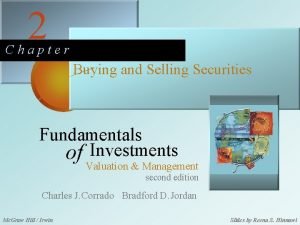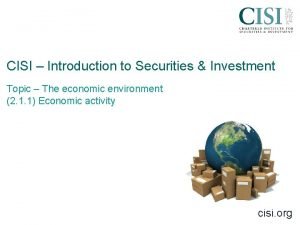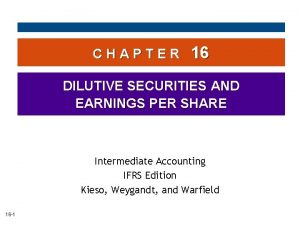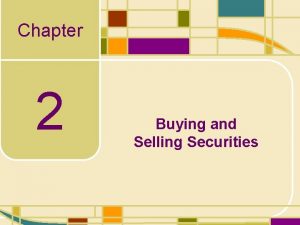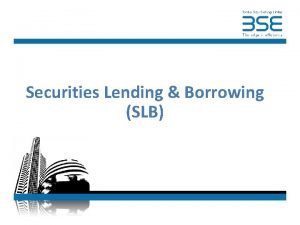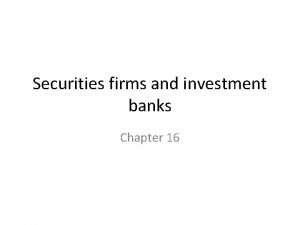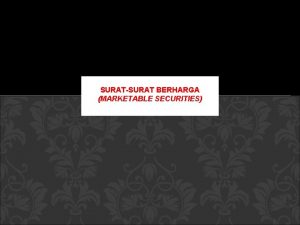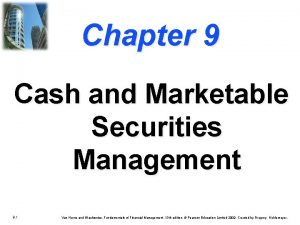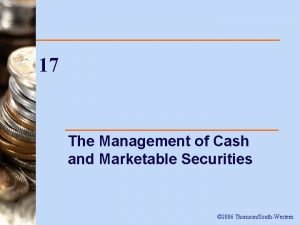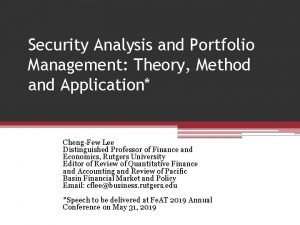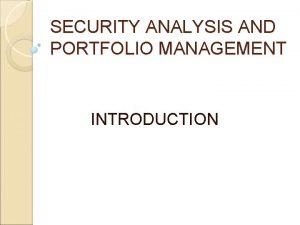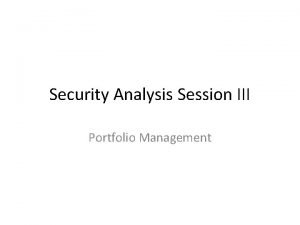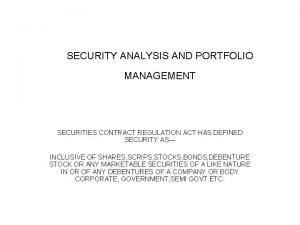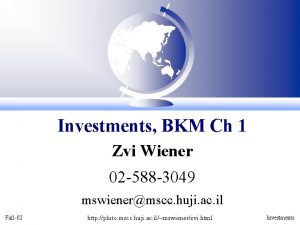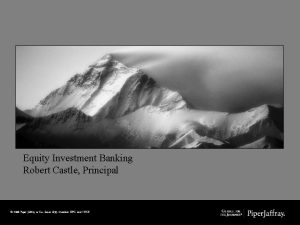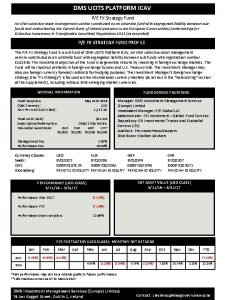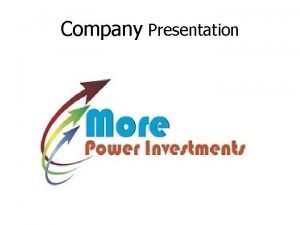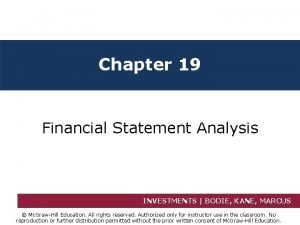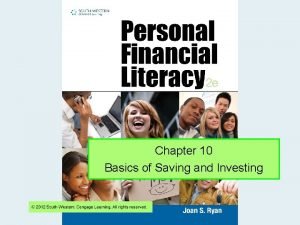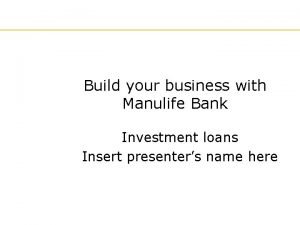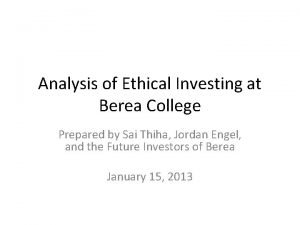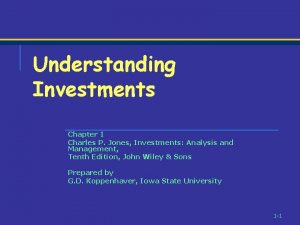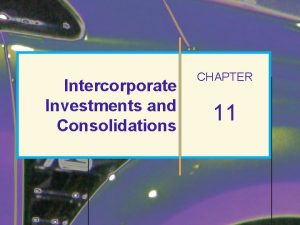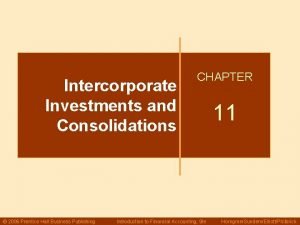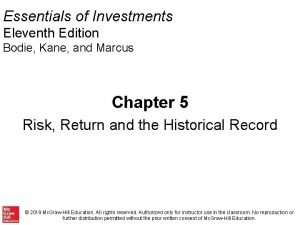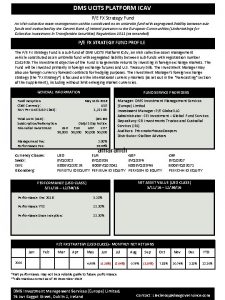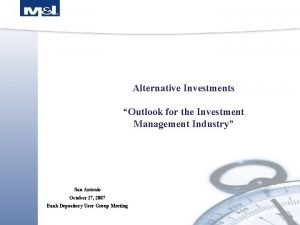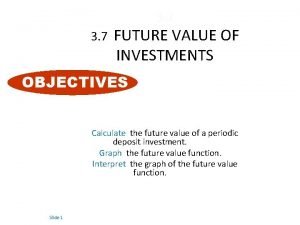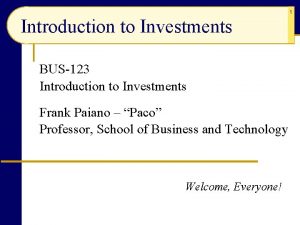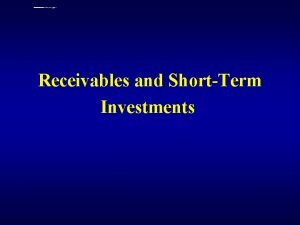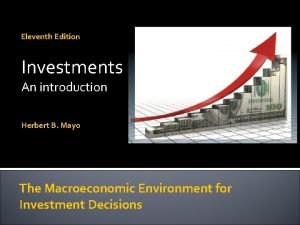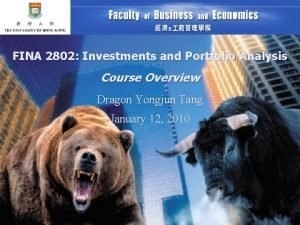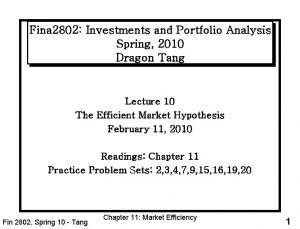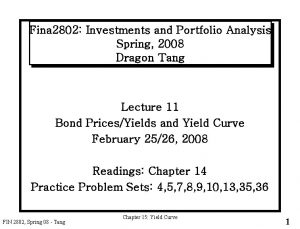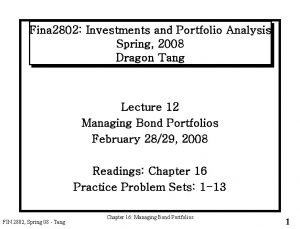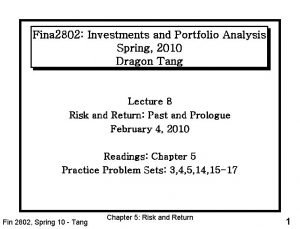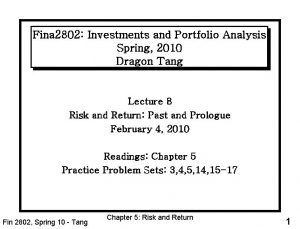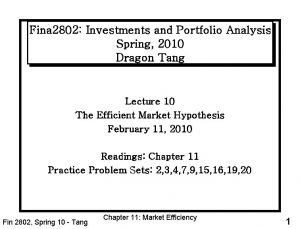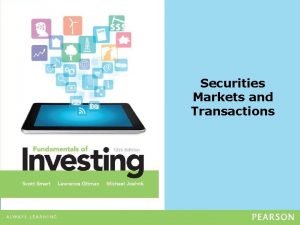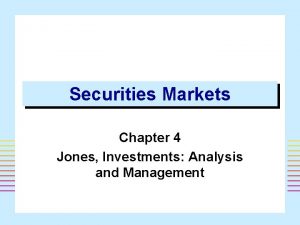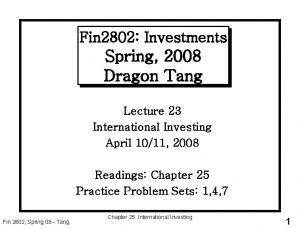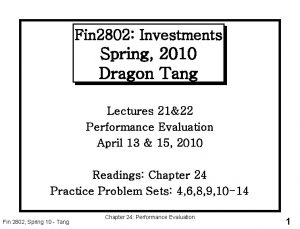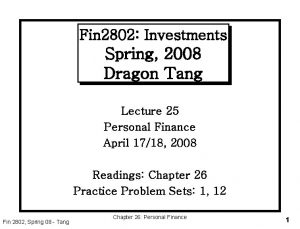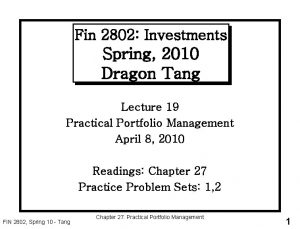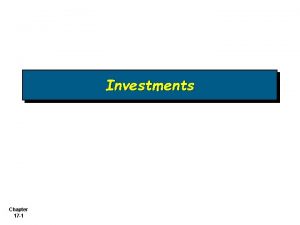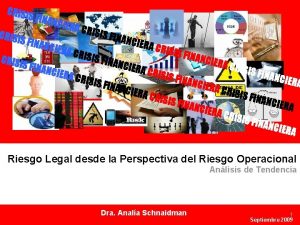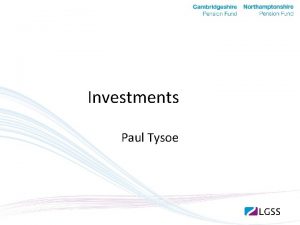FINA 2802 Investments and Portfolio Analysis Securities Markets
































































- Slides: 64

FINA 2802: Investments and Portfolio Analysis Securities Markets Dragon Yongjun Tang January 21 & 23, 2010

Lecture 4 & 5: Securities Markets n Reading: Chapter 3 n Practice Problem Sets: 1, 2, 3, 4, 6, 7, 8, 9, 10, 12, 13, 14, 18, 20, 21 2

Learning Objectives n Role of investment bankers in primary issues n Identify the various security markets n Describe the role of brokers n Compare trading practices in exchanges vs dealer markets n Buy Stock on Margin and Sell Stock Short 3

Life Cycle of a Company Private (Entrepreneur + VC) Primary Secondary Commission Investment Bank Public (NYSE/Nasdaq) Dealer Market Maker Buy on Margin Buy Sell Short Bid-ask Spread Commission Broker Commission Sell 4

How Firms Issue Securities Primary Market: • Initial Public Offering (IPO) • Seasoned Equity Offering (SEO) Investment Bankers: • Assist firms in issuing securities • Firm Commitment (Take a risk in underwriting) • Best efforts (issuer bears the risk of not placement) 5

Figure 3. 1 Relationship Among a Firm Issuing Securities, the Underwriters and the Public 6

Figure 3. 2 A Tombstone Advertisement 7

Shelf Registration SEC Rule 415 Allows firms to register securities and sell them gradually to the public for two years. 8

Private Placements n Firms sell shares directly to a small group of institutional or wealthy investors n Cheaper: No need to register to SEC (Rule 144 A) n Smaller offerings 9

Initial Public Offering (IPO) n. Road shows, bookbuilding n. Cost: commissions (7%) + underpricing n. Investment bankers tend to underprice new issues n. IPO prices tend to rise after IPO (“Money left on the table”) n. IPO are usually poor long-term investments n. Internet Auction 10

IPO Underpricing: A dramatic example (VA Linux) n n IPO price: $30 First day closing price: $239. 25 Today’s price: $1. 00 Replicate this picture using finance. yahoo. com (LNUX) Day's Range: 1. 00 - 1. 04 52 wk Range: 0. 32 – 2. 18 Volume: Avg Vol (3 m): 28, 795 270, 871 Market Cap: P/E (ttm): EPS (ttm): Div & Yield: 64. 31 M N/A -0. 055 N/A (N/A) Last Trade: 1 y Target Est: 1. 0025 1. 59 11

Figure 3. 3 Average Initial Returns for IPOs in Various Countries 12

Figure 3. 4 Long-term Relative Performance of Initial Public Offerings 13

Where Securities Are Traded Secondary Market Organized exchanges – NYSE (or the Big Board); AMEX; regional exchanges n Over the counter (OTC) – Nasdaq: market makers; three levels – Bond trading n Directly between the two parties – Electronic Communication Networks (ECN) n 14

National Market System • Established by Exchange Act of 1975 • Intent was to link firms electronically • Resulted in Consolidated Tape 15

Bond Trading Major concern: Liquidity n. Automated Bond System (ABS) n. OTC market 16

Trading on Exchanges The participants: n Investors n Brokerage firms (owns a “seat” on the exchange) n Commission brokers n Floor brokers 17

Trading on Exchanges The specialist (or market maker): • Makes a market • The brokers’ broker • Maintains the limit order book • Maintains a fair and orderly market NYSE is an example 18

New York Stock Exchange (NYSE) 19

Trading on Exchanges Types of orders: Market n Limit n Day n Good-till-canceled n Stop-loss orders; stop-buy orders n 20

Figure 3. 5 Limit Order Book for Intel on Archipelago 21

Figure 3. 6 Price-Contingent Orders 22

Trading on Exchanges Block orders - at least 10, 000 shares DOT & Super. DOT - direct to specialist Settlement – three business days Shares “In Street Name”. Shares kept by the broker after a transaction 23

Trading on OTC Markets • Negotiated market • No specialist • NASDAQ computer system 24

Nasdaq 25

Market Structures in Other Countries London - predominately electronic trading n Euronext – market formed by combination of the Paris, Amsterdam and Brussels exchanges n Tokyo Stock Exchange n Hong Kong Stock Exchange n Shanghai Stock Exchange n 26

Cost of Trading Broker’s commissions: Explicit “Hidden” costs: Bid-Ask Spread Price Concession 27

Cost of Trading Impact of trading costs on returns

Cost of Trading Example: You bought a stock for $70 and later sold it for $80 You received $8 in dividends, paid an initial broker’s fee of $1% of purchase price, and paid another $1% of selling price when you sold the stock. What is your return on this investment (ignoring taxes)? 29

Placing an Order • Should you use a full-service or a discount broker? • What is the value of the full-service broker’s advice? 30

Student Loan You think your value will go up n You want to make the most out of it n So you borrow money to finance education n 31

Buying on Margin n. Borrow to buy securities (make use of the Broker call’s loan) n. Securities stay with the broker as collateral 32

Buying on Margin Investor’s account: Assets Liabilities Value of stocks purchased Broker Loan from Equity Cost of setting up a margin strategy 33

Buying on Margin n At time 0: n At any future time

Buying on Margin • The Federal Reserve System sets minimum initial margin requirements currently 50% • All exchanges set a minimum maintenance margin requirement currently around 30% 35

Buying on Margin Example: What is the initial margin if the investor purchases 100 shares of stock at $100 per share using $6, 000 of her own money and borrows the rest? 36

Buying on Margin Example (continued): If the value of the above stock fell to $70 per share, what is now the actual margin? 37

Buying on Margin Example (continued): If the value of the above stock fell to $50 per share, what is now the actual margin? 38

Buying on Margin Call Pmin= the lowest price a share can fall to without a call L = the loan value M = the margin requirement N = the number of shares

Buying on Margin Call Example: An investor purchases 100 shares of stock at $100 per share using $6, 000 of her own money and borrows the rest. If the maintenance margin is 30%, what is the lowest price a share can fall without a call? 40

Margin Trading - Initial Conditions X Corp $70 50% Initial Margin 40% Maintenance Margin 1000 Shares Purchased Initial Position Stock $70, 000 Borrowed $35, 000 Equity 35, 000 41

Margin Trading - Maintenance Margin Stock price falls to $60 per share New Position Stock $60, 000 Borrowed $35, 000 Equity 25, 000 Margin% = $25, 000/$60, 000 = 41. 67% 42

Margin Trading - Margin Call How far can the stock price fall before a margin call? (1000 P - $35, 000)* / 1000 P = 40% P = $58. 33 * 1000 P - Amt Borrowed = Equity 43

Problem 3, Chapter 3 (p. 93) Dee Trader opens a brokerage account, and purchases 300 shares of Internet Dreams at $40 per share. She borrows $4, 000 from her broker to help pay for the purchase. The interest rate on the loan is 8%. a. What is the margin in Dee’s account when she first purchases the stock? b. If the share price falls to $30 per share by the end of the year, what is the remaining margin in her account? If the maintenance margin requirement is 30%, will she receive a margin call? c. What is the rate of return on her investment 44

Problem 7, Chapter 3 (p. 94) You are bullish on Telecom stock. The current market price is $50 per share, and you have $5, 000 of your own to invest. You borrow an additional $5, 000 from your broker at an interest rate of 8% per year and invest $10, 000 in the stock. a. What will be your rate of return if the price of Telecom stock goes up by 10% during the next year? (Ignore the expected dividend. ) b. How far does the price of Telecom stock have to fall for you to get a margin call if the maintenance margin is 30% of the value of the short position? Assume the price all happens immediately. 45

Why buy on margin? Borrowing magnifies ROE (risky strategy)

Leverage and ROE 47

Short Sales Borrow Securities to sell them Sell first -- then buy! Margin is required (cost of short selling) Short position must be covered Investor expects price to decline 48

Short Selling Original Stock Holder 100 Shares Broker 100 Shares Short Seller 100 Shares New Stock Holder 49

Short Sales

Short Sales Example: An investor sells short 100 shares of stock at $100 per share. The margin requirement is 50% of the short sale. a. If the investor covers her short sale when the stock price declines to $70 per share, what is the return on the short sale? b. What is the return if there is no margin requirement? 51

Short Sales Example: An investor sells short 100 shares of stock at $100 per share. The margin requirement is 50% of the short sale. c. If the investor covers her short sale when the stock price increases to $130 per share, what is the return on the short sale? 52

Short Sales-Initial Margin Investor’s account at time 0: Assets Value of stocks sold owed Initial Margin (E 0) Liabilities Value of Stocks Equity (Current Margin) Percentage Initial Margin= As time elapses, the value of stocks owed changes, affecting the %Margin!

Short Sales-Margin Investor’s account at time t: Assets Value of stocks sold owed Initial Margin (E 0) Liabilities Value of Stocks DIVIDENDS DUE Equity (Et=Current Margin) Percentage Margin= As time elapses, the value of stocks owed changes, affecting the %Margin!

Short Sales -Margin How high can the price of stock go before a margin call is issued? Actual margin= We want actual margin > required margin. Solve for

Short Sales Margin call price:

Short Sales Example: An investor sells short 100 shares of stock at $100 per share. The initial margin requirement is 50% of the short sale. If the maintenance margin is 30%, what is the maximum stock price without a margin call on the short sale? 57

Short Sale - Initial Conditions Z Corp 50% 30% $100 Shares Initial Margin Maintenance Margin Initial Price Sale Proceeds $10, 000 Margin & Equity 5, 000 Stock Owed 10, 000 58

Short Sale - Maintenance Margin Stock Price Rises to $110 Sale Proceeds $10, 000 Initial Margin 5, 000 Stock Owed 11, 000 Net Equity 4, 000 Margin % (4000/11000) 36% 59

Short Sale - Margin Call How much can the stock price rise before a margin call? ($15, 000* - 100 P) / (100 P) = 30% P = $115. 38 * Initial margin plus sale proceeds 60

Problem 4, Chapter 3 (p. 93) Old Economy Traders opened an account to short sell 1, 000 shares of Internet Dreams from Question 3. The initial margin requirement was 50%. (The margin account pays no interest. ) A year later, the price of Internet Dreams has risen from $40 to $50, and the stock has paid a dividend of $2 per share. a. What is the remaining margin in the account? b. If the maintenance margin requirement is 30%, will Old Economy receive a margin call? c. What is the rate of return on the investment? 61

Problem 8, Chapter 3 (p. 94) You are bearish on Telecom and decide to sell short 100 shares at the current market price of $50 per share. a. How much in cash or securities must you put into your brokerage account if the broker’s initial margin requirement is 50% of the value of the short position? b. How high can the price of the stock go before you get a margin call if the maintenance margin is 30% of the value of the short position? 62

Regulations of Securities Markets n. Securities Act of 1933 n. Securities Exchange Act of 1934 n. Securities Investor Protection Act of 1970 n. Blue Sky Laws n. Circuit Breakers n. Main Concern: Insider Trading n. Trading scandals and reactions: Sarbanes-Oxley Act 63

Summary Issuing securities n Trading n Buying on margin and short sales n Next class: Mutual Funds n 64
 Capital markets tribunal
Capital markets tribunal What is marketable securities
What is marketable securities Efficient securities markets imply that
Efficient securities markets imply that International portfolio investments
International portfolio investments International portfolio investments
International portfolio investments Cycles in nature
Cycles in nature Personal values statement examples for students
Personal values statement examples for students Turbotarara
Turbotarara Lide e linha fina
Lide e linha fina Uninucleada
Uninucleada Fina potpisni modul
Fina potpisni modul Fina jrr
Fina jrr Fina 3210
Fina 3210 Reg zap
Reg zap Envoltura gaseosa del planeta tierra
Envoltura gaseosa del planeta tierra Fina tema
Fina tema Giulia agnolin
Giulia agnolin Define fina
Define fina Rutherford bombardeou uma fina lamina
Rutherford bombardeou uma fina lamina Ministerul fina
Ministerul fina Chapter 11 real estate and other investments
Chapter 11 real estate and other investments In managing cash and marketable securities
In managing cash and marketable securities Buying and selling of securities
Buying and selling of securities Cisi introduction to securities and investment
Cisi introduction to securities and investment Diluted earnings per share
Diluted earnings per share What is buying and selling of securities
What is buying and selling of securities Cash and marketable securities
Cash and marketable securities Sds security services
Sds security services Securities lending and borrowing example
Securities lending and borrowing example Securities firms and investment banks
Securities firms and investment banks Cash and marketable securities management
Cash and marketable securities management Cash and marketable securities management
Cash and marketable securities management Cash and securities management
Cash and securities management Security analysis and portfolio management project
Security analysis and portfolio management project Security analysis and portfolio management project
Security analysis and portfolio management project Investment analysis and portfolio management notes for mba
Investment analysis and portfolio management notes for mba Importance of security analysis and portfolio management
Importance of security analysis and portfolio management Risk in security analysis and portfolio management
Risk in security analysis and portfolio management Scope of investment analysis and portfolio management
Scope of investment analysis and portfolio management Investment analysis and portfolio management course
Investment analysis and portfolio management course Consolidated retained earnings
Consolidated retained earnings Fundamentals of analyzing real estate investments download
Fundamentals of analyzing real estate investments download Intermediate accounting chapter 17 investments pdf
Intermediate accounting chapter 17 investments pdf 02 588
02 588 Investments bodie kane marcus
Investments bodie kane marcus Loarre investments
Loarre investments Strategie consulting dms
Strategie consulting dms Morepower
Morepower Investments bodie kane marcus summary
Investments bodie kane marcus summary Chapter 10 basics of saving and investing
Chapter 10 basics of saving and investing Manulife rrsp loan
Manulife rrsp loan Investments berea
Investments berea Accounting chapter 6
Accounting chapter 6 Bus-123: introduction to investments
Bus-123: introduction to investments Understanding investments
Understanding investments Intercorporate investments
Intercorporate investments Intercorporate investments
Intercorporate investments Essentials of investments 11th edition
Essentials of investments 11th edition Pe investments fx strategy
Pe investments fx strategy Alternative investment outlook
Alternative investment outlook 3-7 future value of investments answers
3-7 future value of investments answers Bus-123: introduction to investments
Bus-123: introduction to investments Accounting for short term investments
Accounting for short term investments 3-7 future value of investments answers
3-7 future value of investments answers Investments an introduction
Investments an introduction
